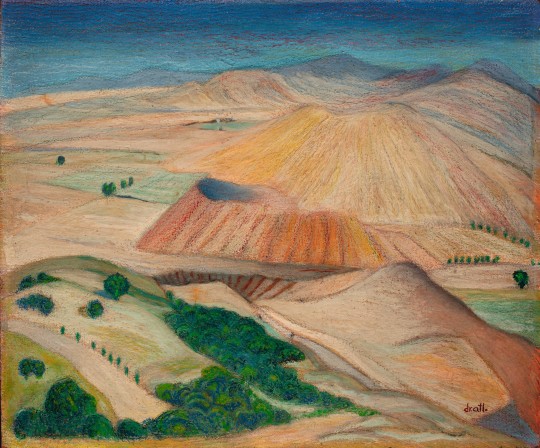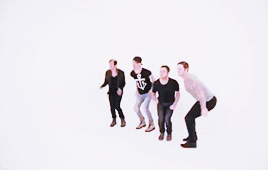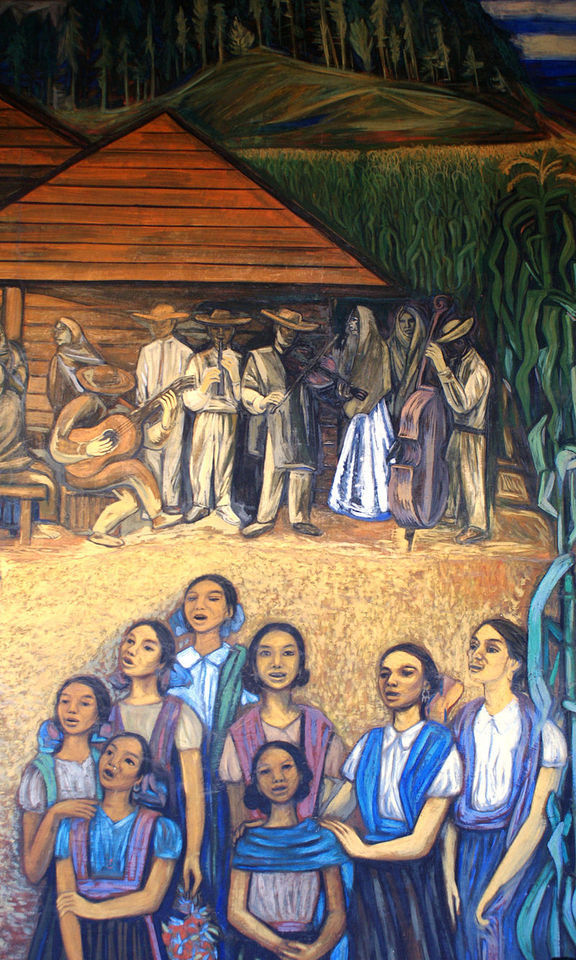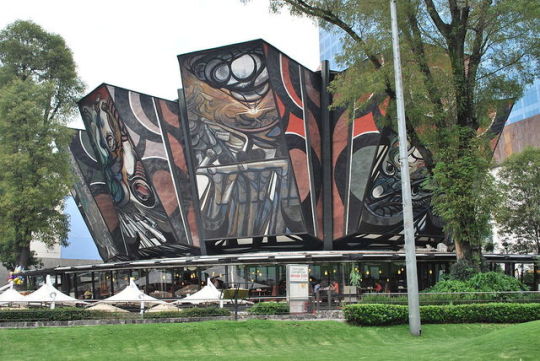#atlcolor
Photo

Dr. Atl (Mexican, 1875-1964), Paisaje [Landscape], c.1940. Atlcolor on Masonite, 22.75 x 26.75 in.
155 notes
·
View notes
Photo








all time low + colors [white]
“we all sleep together.”
#this is all from the same video because????i m a lazy asshole#the guts to say anything#my post#atlcolors#all time low#alex gaskarth#jack barakat#rian dawson#zack merrick#all time low edit#mine#m.c
121 notes
·
View notes
Photo




Dr. Atl designed the -atlcolors-, a mixture of pigments, resins and oils that created a material capable of adhering to almost any surface. This is the reason for the characteristic texture of many of his easel works.
Eruption of the Paricutín, 1943. (details) Museo Nacional de Arte, Mexico.
Dr. Atl diseñó los -atlcolors-, una mezcla de pigmentos, resinas y óleos que creaban un material capaz de adherirse a casi cualquier superficie. Esta es la razón de la textura característica de muchas de sus obras de caballete.
Eruption of the Paricutín, 1943. (detalles) Museo Nacional de Arte, México.
32 notes
·
View notes
Photo

styldLife_ check out the gorgeous #color and #beachwaves by #celebrity #stylist @facemefierce want to learn how to #getthelook yourself? You can also book a personalized video appointment with @facemefierce @ styldLife.com. See what 15, 30 or 55 min can do for you! #beautiful #glamour #glamorous #glamsquad #longhair #stylish #firstdate #fashionista #holiday #party #repost #Repost @facemefierce with @get_repost ・・・ Balayage work from today #balayage #color #salonflow #colorist #hairstylist #hairdesign #beachwaves #onpoint #fleek #atlhair #atlcolor #atlhaircolor #atlstylist #mobliesalon #learnmytricks
#atlhaircolor#atlstylist#balayage#color#beachwaves#salonflow#repost#firstdate#atlcolor#longhair#glamorous#hairdesign#beautiful#stylist#fashionista#party#onpoint#learnmytricks#colorist#glamour#celebrity#mobliesalon#hairstylist#atlhair#holiday#getthelook#glamsquad#fleek#stylish
0 notes
Photo

Hey ladies take advantage of these amazing November hair specials and sales! ⭐️ Traditional Sew IN $90 Monday’s ONLY! $99 tues -sat Frontal Sew In installations $150 Closure Sew In Installations $125 Quickweaves $75 Monday’s ONLY! $85 ties-sat $50 bundles online only! ... bundles up to 22 inches ... body wave / Straight and deep wave textures ... send orders to [email protected] must mention ad to receive discounts! For booking visit augustsnowhair.acuityscheduling.com For immediate assistance contact me directly at 317.918.5114 #augustsnow #augustsnowhair #augustsnowatl #atlhair #hairatl #atlantahairstylist #atlhairsalon #atlweaves #weavesatl #atlantasewin #sewinatl #atlantacurls #atlcolor #atlfrontal #frontalsewin #closuresewin #middlepartsewin #atlantaquickweaves #atlbundledeals #suite78 #suite78hair
#atlantacurls#augustsnowatl#atlcolor#hairatl#suite78#augustsnowhair#frontalsewin#atlweaves#middlepartsewin#suite78hair#atlantahairstylist#atlbundledeals#atlhairsalon#atlantaquickweaves#augustsnow#sewinatl#closuresewin#atlhair#weavesatl#atlantasewin#atlfrontal
0 notes
Photo

Come through👊👊🔥🔥 When that one of ur few male clients breaks the I. . . . . #atlcolor #atlcut #atlswag #atlstyle #atlmodel #atlfashion #atlfashionweek #atl
0 notes
Photo




Mexican muralism was the promotion of mural painting starting in the 1920s, generally with social and political messages as part of efforts to reunify the country under the post Mexican Revolution government. It was headed by “the big three” painters, Diego Rivera, José Clemente Orozco and David Alfaro Siqueiros. From the 1920s to about 1970s a large number of murals with nationalistic, social and political messages were created on public buildings, starting a tradition which continues to this day in Mexico and has had impact in other parts of the Americas, including the United States where it served as inspiration for the Chicano art movement.
Mexico has had a tradition of painting murals, starting with the Olmec civilization in the pre Hispanic period and into the colonial period, with murals mostly painted to evangelize and reinforce Christian doctrine. The modern tradition has its roots in the 19th century, with this use of political and social themes. The first Mexican mural painter to use philosophical themes in his work was Juan Cordero in the mid 19th century. Although he did mostly work with religious themes such as the cupola of the Santa Teresa Church and other churches, he painted a secular mural at the request of Gabino Barreda at the Escuela Nacional Preparatoria (since disappeared).
The latter 19th century was dominated politically by the Porfirio Díaz regime. This government was the first to push for the cultural development of the country, supporting the Academy of San Carlos and sending promising artists abroad to study. However, this effort left out indigenous culture and people, with the aim of making Mexico like Europe. Gerardo Murillo, also known as Dr. Atl, is considered to be the first modern Mexican muralists with the idea that Mexican art should reflect Mexican life. Academy training and the government had only promoted imitations of European art. Atl and other early muralists pressured the Diaz government to allow them to paint on building walls to escape this formalism. Atl also organized an independent exhibition of native Mexican artists promoting many indigenous and national themes along with color schemes that would later appear in mural painting. The first modern Mexican mural, painted by Atl, was a series of female nudes using “Atlcolor” a substance Atl invented himself, very shortly before the beginning of the Mexican Revolution . Another influence on the young artists of the late Porfirian period was the graphic work of José Guadalupe Posada, who mocked European styles and created cartoons with social and political criticism.
The Mexican Revolution itself was the culmination of political and social opposition to Porfirio Díaz policies. One important oppositional group was a small intellectual community that included Antonio Curo, Alfonso Reyes and José Vasconcelos. They promoted a populist philosophy that coincided with the social and political criticism of Atl and Posada and influenced the next generation of painters such as Diego Rivera, José Clemente Orozco and David Alfaro Siqueiros.
These ideas gained power as a result of the Mexican Revolution, which overthrew the Díaz regime in less than a year. However, there was nearly a decade of fighting among the various factions vying for power. Governments changed frequently with a number of assassinations, including that of Francisco I. Madero who initiated the struggle. It ended in the early 1920s with one-party rule in the hands of the Álvaro Obregón faction, which became the Partido Revolucionario Institucional (PRI). During the Revolution, Atl supported the Carranza faction and promoted the work of Rivera, Orozco and Siqueiros, who would later be the founders of the muralism movement. Through the war and until 1921, Atl continued to paint murals among other activities including teaching the Mexico’s next generation of artists and muralists.
Mural movement
Eagle and snake image from the Colegio San Ildefonso project by Jean Charlot.
In 1921, after the end of the military phase of the Revolution, José Vasconcelos was appointed to head the Secretaría de Educación Pública. At the time, most of the Mexican population was illiterate and the government needed a way to promote the ideals of the Mexican Revolution. It was Vasconcelos’s idea have a government-backed mural program for this purpose. Similar to mural use in the pre Hispanic period and during the colonial period, the purpose of these murals were not simply aesthetic, but social, to promote certain ideals.
These ideals or principles were to glorify the Mexican Revolution and the identity of Mexico as a mestizo nation, with the indigenous promoted as well as the Spanish. The government began to hire the country’s best artists to paint murals, calling some of them home from Europe including Diego Rivera. These initial muralists included Dr. Atl, Ramón Alva de la Canal, Federico Cantú and others but the main three would be David Alfaro Siqueiros, José Clemente Orozco and Diego Rivera. His time as secretary was short but it set how muralism would develop. His image was painted on a tempera mural in 1921 by Roberto Montenegro, but this was short lived. His successor at the Secretaría de Educación Pública ordered it painted out. The muralists differed in style and temperament, but all believed that art was for the education and betterment of the people. This was behind their acceptance of these commissions as well as their creation of the Syndicate of Technical Workers, Painters, and Sculptors.
The first government sponsored mural project was on the three levels of interior walls of the old Jesuit institution Colegio San Ildefonso, at that time used for the Escuela Nacional Preparatoria. However, most of the murals in the Escuela National Preparatoria were done by José Clemente Orozco with themes of a mestizo Mexico, the ideas of renovation and the tragedies of the Revolution; Fernando Leal painted ["dancers of Chalma"] "Los danzantes de Chalma", no earlier than 1922. Opposite that mural, Jean Charlot painted La conquista de Tenochtitlán (Conquest of Tenochtitlan) by Jean Charlot—invited by Leal.
After the mural project at the National Preparatory High School
This project at the institution was followed by projects at the Palacio Nacional, the interior walls of the Palacio de Bellas Artes, the Escuela Nacional de Chapingo the Escuela Nacional de Medicina and the Secretaria de Educación Pública building among many others.
The movement was strongest from the 1920s to the 1950s, which corresponded to the country’s transformation from a mostly rural and mostly illiterate society to an industrialized one. While today they are part of Mexico’s identity, at the time they were controversial, especially those with socialist messages plastered on centuries-old colonial buildings. One of the basic underpinnings of the nascence of a post revolutionary Mexican art was that it should be public, available to the citizenry and above all not the province of a few wealthy collectors. The great societal upheaval made the concept possible as well as a lack of relatively wealthy middle class to support the arts. On this, the painters and the government agreed. One other point of agreement was that artists should have complete freedom of expression. This would lead to another element added to the murals over their development. In addition to the original ideas of a reconstructed Mexico and the elevation of Mexico’s indigenous and rural identity, many of the muralists, including the three main painters, also included elements of Marxism, especially the struggle of the working class against oppression.
The inception and early years of Mexico's muralist movement are often considered the most ideologically pure and untainted by contradictions between socialist ideals and government manipulation. This initial phase is referred to as the "heroic" phase while the period after 1930 is the "statist" phase with the transition to the latter phase caused by José Vasconcelos's resignation in 1924.
Scholar Mary Coffey describes those who "acknowledge a change but refrain from judgment about its consequences" as taking the soft line and those who see all murals after 1930 as "propaganda for a corrupt state" as taking a hard line.[9] Another stance is that the evolution of Mexican muralism as having an uncomplicated relationship with the government and as an accurate reflection of avant-garde and proletariat sentiments. However, hard liners see the movement as complicit in the corrupt government's power consolidation under the guise of a socialist regime.
Art historian Leonard Folgarait has a slightly different view. He marks 1940 as the end of the post-revolutionary period in Mexico as well as the renaissance era of the muralist movement. The conclusion of the Lázaro Cárdenas administration (1934 – 1940) and the beginning of the Manuel Avila Camacho (1940 – 1946) administration saw the rise of an ultraconservative Mexico. The country’s policy was aimed at maintaining and strengthening a capitalist society.[10] Mural artists like the Big Three spent the post-revolutionary period developing their work based on the promises of a better future, and with the advent of conservatism they lost their subject and their voice.
The Mexican government began to distance itself from mural projects and mural production became relatively privatized. This privatization was a result of patronage from the growing national bourgeoisie. Murals were increasingly contracted for theaters, banks, and hotels.
Artistry
Mural by Jorge González Camarena at the Palacio de Bellas Artes
Mexican populist art production from the 1920s to the 1950s is often grouped under the name of “Escuela Mexicana de Pintura (y Escultura) (Mexican School of Painting and Sculpture), coined in the 1930s by art historians and critics. The term is not well-defined as it does not distinguish among some important stylistic and thematic difference, there is no firm agreement which artists belong to it nor if muralism should be considered part of it or separate. It is not a school in the classic sense of the word as it includes work by more than one generation and with different styles that sometimes clash. However, it does involve a number of important characteristics. Mexican School mural painting was a combination of public ideals and artistic aesthetics “positioned as a constituent of the official public sphere.” Three formal components of official Mexican muralism are defined as: 1) Direct participation in official publicity and discourse 2) Reciprocal integration of the visual discourse of the mural to an array of communicative practices participant in defining official publicity (including a variety of scriptural genres, but also public speech, debate and provocative public “event”) 3) The development and public thematizing of a social-realist aesthetic (albeit multiform in character) as the visual register for the public sense of the mural work and as the doxic, or unquestioned, limits for public dispute over the representational space of the mural image Most painters in this school worked in Mexico City or other cities in Mexico, working almost uninterrupted on projects and/or as teachers, generally with support of the government. Most were concerned with the history and identity of Mexico and politically active. Most art from this school was not created for direct sale but rather for diffusion in both Mexico and abroad. Most were formally trained, often studying in Europe and/or in the Academy of San Carlos.
Mural by Alfredo Zalce at the state government palace in Morelia.
A large quantity of murals were produced in most of the country from the 1920s to 1970, generally with themes related to politics and nationalism focused often on the Mexican Revolution, mestizo identity and Mesoamerican cultural history. These served as a form of cohesion among members of the movement. The political and nationalistic aspects had little directly to do with the Mexican Revolution, especially in the later decades. The goal was more to glorify it and its results as a means to legitimatize the post Revolution government. The other political orientation was that of Marxism, especially class struggle. This was strongest in the early movement with Rivera, Orozco and Siqueiros all avowed communists. The political messages became less radical but they remained firmly to the left. Much of the mural production glorified the indigenous aspect of Mexican culture, considering it an important factor in the creation of modern Mexico. This was added with the idea of reexamining the country’s history from a different perspective. One other aspect that most of the muralists shared was a rejection of the idea that art was only for the elite, but rather as a benefit for the masses.
The murals took on monumental status because of where they were situated, mostly on the walls of colonial era government buildings and the themes that were painted. The mural painters of Mexico freely shared ideas and techniques as they were a closely knit group. However, the work of each was distinctive as the government did not set style and artists can generally be deduced without looking at signatures. Techniques included the revival of old techniques such as the fresco, painting on freshly plastered walls and encaustic or hot wax painting .
Others used mosaics and high fire ceramics, as well as metal parts, and layers of cement. The most innovative of the artists was Siqueiros who worked with pyroxlene, a commercial enamel and Duco (used to paint cars), resins, asbestos, old machinery and was one of the first to use airbrush for artistic purposes. He pored, sprayed, dripped and splattered paint for the effects they created haphazardly.
Los Tres Grandes
Mural in the main stairwell of the National Palace by Diego Rivera
By far, the three most influential muralists from the 20th century are Diego Rivera, José Clemente Orozco, and David Siqueiros, called “los tres grandes” (the three great ones). All believed that art was the highest form of human expression and a key force in social revolution. Their work defined the movement taking over from Vasconcelos. It created a mythology around the Mexican Revolution and the Mexican people which is still influential to this day, as well as promote Marxist ideals. At the time the works were painted, they also served as a form of catharsis over what the country had endured during the war. However, the three were different in their artistic expression. Rivera’s works were utopian and idealist, Orozco’s were critical and pessimistic and the most radical were those of Siqueiros, heavily focused on a scientific future. The differences among the three have much to do with how each experienced the Mexican Revolution. Rivera was in Europe the entire time and did not fight. He never depicted the horrors of the war but what he perceived to be the social benefits from it. The other two did and both did express the horrors of war in their work. There was resentment to Rivera by the other two because of it, especially from Siqueiros.
Of the three, Rivera was the most traditional in terms of painting styles, drawing heavily from European modernism. In his narrative mural images, Rivera incorporated elements of cubism His themes were Mexican, often scenes of everyday life and images of ancient Mexico. He originally painted this in bright colors in the European style but modified it to more earthy tones to imitate indigenous murals. His greatest contribution is the promotion of Mexico’s indigenous past into how many people both inside and outside of the country view it.
Orozco also began with a European style of expression. However his art developed into an angry denunciation of oppression especially by those he considered to be an evil and brutal rules class. His work was somber and dire, with emphasis on human suffering and fear of the technology of the future. His work shows an "expressionist use of color, slashing lines, and parodic distortions of the human figure." Like most other muralists, Orozco condemned the Spanish as destroyers of indigenous culture, but he did have kinder depictions such as that of a Franciscan friar tending to an emaciated indigenous period. Unlike other artists, Orozco never glorified the Mexican Revolution, having fought in it, but rather depicted the horrors of this war. It caused many of his murals to be heavily criticized and even defaced.
Siqueiros was the youngest and most radical of the three. He joined the Venustiano Carranza army when he was eighteen and experienced the Revolution from the front lines. Although all three muralists were communists, Siqueiros was the most dedicated, as evidenced by his portrayals of the proletarian masses. His work is also characterized with rapid, sweeping, bold lines and the use of modern enamels, machinery and other elements related to technology. His style showed a "futurist blurring of form and technique." His fascination with technology as it relates to art was exemplified when he emphasized the mass communications visual technology of photograph and motion picture in his eventual movement toward neorealism. His radical politics made him unwelcome in Mexico and the United States, so he did much of his work in South America.[5][7] However, his masterpiece is considered to be the Polyforum Cultural Siqueiros, located in Mexico City.
The Big Three struggled to express their leftist leanings after the initial years painting murals under government supervision. These struggles with the post-revolution government lead the muralists to create a union of artists and produce a radical manifesto. José Vasconcelos, the Secretary of Public Education under President Álvaro Obregón (1920–24) contracted Rivera, Siqueiros, and Orozco to pursue painting with the moral and financial support of the new post-revolutionary government. Vasconcelos, while seeking to promote nationalism and “raza cosmica,” seemed to contradict this sentiment as he guided the muralists to create works in a classic, European style. The murals became a target of Vasconcelos’s criticism when the Big Three departed from classical proportion and figure. Siqueiros was dissatisfied with the incongruity between the murals and the revolutionary concerns of the muralists, and he advocated discussion among the artists of their future works.
In 1922 the muralists founded the Union of Revolutionary Technical Workers, Painters, and Sculptors of Mexico. The Union then released a manifesto listing education, art of public utility, and beauty for all as the social goals of their future artistic endeavors.
Influence
After nearly a century since the beginning of the movement, Mexican artists still produce murals and other forms of art with the same “mestizo” message. Murals can be found in government buildings, former churches and schools in nearly every part of the country. One recent example is a cross cultural project in 2009 to paint a mural in the municipal market of Teotitlán del Valle, a small town in the state of Oaxaca. High school and college students from Georgia, United States, collaborated with town authorities to design and paint a mural to promote nutrition, environmental protection, education and the preservation of Zapotec language and customs.
Mexican muralism brought mural painting back to the forefront of Western art in the 20th century with its influence spreading abroad, especially promoting the idea of mural painting as a form of promoting social and political ideas. It offered an alternative to non-representational abstraction after World War I with figurative works that reflect society and its immediate concerns. While most Mexican muralists had little desire to be part of the international art scene, their influence spread to other parts of the Americas. Notable muralists influenced by Mexican muralism include Carlos Mérida of Guatemala, Oswaldo Guayasamín of Ecuador and Candido Portinari of Brazil .
Rivera, Orozco, and Siqueiros all spent time in the United States. Orozco was the first to paint murals in the late 1920s at Pomona College in Claremont, California, staying until 1934 and becoming popular with academic institutions.During the Great Depression, the Works Progress Administration employed artists to paint murals, which paved the way for Mexican muralists to find commissions in the country. Rivera lived in the United States from 1930 to 1934. During this time, he put on an influential show of his easel work at the Museum of Modern Art. The success of Orozco and Rivera prompted U.S. artists to study in Mexico and opened doors for many other Mexican artists to find work in the country. Siqueiros did not fare as well. He was exiled to the US from Mexico in 1932, moving to Los Angeles. During this time, he painted three murals, but they were painted over. The only one of the three to survive, América Tropical (full name: América Tropical: Oprimida y Destrozada por los Imperialismos, or Tropical America: Oppressed and Destroyed by Imperialism), was restored by the Getty Conservation Institute and the América Tropical Interpretive Center opened to provide public access.
The concept of mural as political message was transplanted to the United States, especially in the former Mexican territory of the Southwest. It served as inspiration to the later Chicano muralism but the political messages are different. Revolutionary Nicaragua developed a tradition of muralism during the Sandinista period.
39 notes
·
View notes
Text
Recordando al Doctor Atl
No fue fotógrafo pero sí pintor que usó fotografías, lo que es suficiente para hablar de él en este blog fotográfico. Recordémoslo:
Un genio, el Doctor Atl. Pintor Grande. Dibujante y grabador. Precursor e impulsor del muralismo. Maestro de Orozco, Rivera y Siqueiros. Inventor. Inventó los “atlcolors” y también el “aeropaisaje” -visión que he usado para fotografiar al Popocatépetl y al Iztaccíhuatl. Y hablando de volcanes, el Doctor Atl (Doctor Agua) fue uno de sus más grandes observadores y apasionados. Vulcanólogo sin título, vulcanólogo de hecho, por lo hecho (Cómo nace y crece un volcán). Hombre inspirador. Doctor doble: doctor sin doctorado, doctorado en el Nombre. Doctor por Obra. Personaje superior. Grandiosa obra la del admirable Doctor Atl.
1 note
·
View note
Text
Three Mexican Artists Who Aren’t Diego Rivera
It’s Cinco de Mayo!
The day that is NOT Mexican Independence Day and IS the celebration of the Mexican Army’s 1862 defeat of the French in the Battle of Puebla. It IS a day to celebrate Mexican and Mexican American culture by learning about the history, literature, art, food, and, naturally, drink of this glorious people. It is NOT an excuse to perpetuate racist stereotypes so please only partake in said drink if you can keep your Speedy Gonzales imitation to yourself after a few rounds.
Previously we have aided in your tequila drinking and art loving by bringing you Frida Kahlo inspired drinks. While we will always adore Kahlo and her famous artist husband Diego Rivera, wouldn’t it be nice on a day meant to celebrate Mexican culture to raise our Kahlo shot glasses salted from our Kahlo + Rivera salt shakers to some of the other influential Mexican artists in the world? With this goal in mind today we bring you just three, of what we assure you are many, amazing male Mexican artists who are NOT Diego Rivera.
Why no ladies? We wanted to give them their own rightfully deserved blog so stay tuned to Sartle to learn about the spectacular surrealists and powerful portraitists who are not Kahlo.
JOSE GUADALUPE POSADA
A Portrait of Posada in his Shop by Leopoldo M’endez from the Los Angeles County Art Museum
With a single work Jose Guadalupe Posada has arguably held more influence over Mexican art within the past 100 years than any other artist.
La calavera Oaxaqueña calavera del montón from the Amon Carter Museum of American Art
Considered the father of Mexican satirical printmaking, Posada worked tirelessly throughout his career from 1868-1913 creating lithographs, engravings, and wood blocks that depicted both natural and political events faced by Mexico’s working poor. Through these cheaply produced graphic illustrations printed on pamphlets and newspapers Posada sought to provide accessible news and entertainment to keep even the illiterate members of Mexican society informed. His work, but not his name, reached the masses and he died largely unrecognized in 1913, buried a pauper in a 6th class grave in Mexico City’s Dolores Cemetery where seven years later his unclaimed remains were discarded.
Posada’s name is still not well known outside of Mexico, a sad circumstance when considering that he is responsible for creating this:
The lovely lady above was deemed La Calavera Garbancera by Posada but thanks to Diego Rivera is now known commonly as La Calvera Catrina and is the uncited source of every Dia de Los Muertos costume you’ve ever seen. In the original title, “garbancera” refers to a term used in Posada’s time to describe indigenous Mexicans who tried to downplay their heritage by embracing the European styles of the upper-class, with “calavera,” which translates to “skull,” representing a skeleton character popular in folkloric Mexican art. While Calaveras have long existed in Mexico, it was Posada who is credited for providing the finery featured in modern renderings of the character. The Calavera reference Mexican culture’s strong link between the living and the dead dating back to Pre-Colombian traditions honoring the Aztec goddess of death, Mictecacihuatl.
Mictecacihuatl guards the bones of the dead in the underworld where she reigns as Queen.
La Calvera Catrina received her new name and new fame 34 years after Posada’s death and 37 years after her inception when Diego “The Frog Prince” Rivera included her in his famed 1947 mural Sueño de una tarde dominical en la Alameda Central (“Dream of a Sunday Afternoon in Alameda Park”). Catrina stands between images of a young Rivera and Posada himself. As a result of Rivera’s mural, La Calvera Catrina’s image grew in popularity, eventually becoming not only a symbol in Dia De Los Muertos celebrations held on November 1st and 2nd but one of the most prevalent symbols of Mexican culture today.
Detail from Diego Rivera’s Dreams of a Sunday Afternoon in Alameda Central Park from the Diego Rivera Mural Museum
Posada has gained some posthumous recognition for his contributions to Mexican art. The study of his work by French art critic Jean Charlot in the mid 1920s led to his resurgence evidenced in the murals of the revolution and a museum dedicated to his work has been open in his hometown of Aguascalientes since 1972. Despite his significant influence he is little discussed outside of Mexico proving what Rivera once said true, that Posada’s work is, “so great that perhaps one day his name will be forgotten!”
DR. ATL (GERARDO MURILLO)
Self-Portrait with Popocatépetl by Dr. Atl from the Philadelphia Museum of Art
The Mexican Muralist Movement of which Diego Rivera was part ran from the mid 1920s through the 1970s. The movement was known for politically charged work often championing socialist ideals by commenting on the oppression of the working man and indigenous customs by the bourgeois in power. Fittingly the murals blended traditional Mexican imagery with European painting styles, often citing the post-impressionism of Cezanne and the cubism of Picasso. Rivera’s status as the most identifiable name within this movement is due in large part to fellow artist and writer Gerardo Murillo, more commonly known as Dr. Atl.
In 1897, a young Murillo was sent to study painting in Europe with a pension granted to him by President Diaz, the very man he would rally against during the Mexican Revolution beginning in 1910. It was during this trip to Europe that Murillo not only refined his art and reportedly walked from Rome to Paris and Paris to Madrid, but also became involved with the Italian Socialist Party. In 1902 Murillo changed his name to Dr. Atl to adopt a more indigenous identity and upon returning to Mexico began his long career of revolutionizing Mexican art.
An image from Dr. Atl’s 1922 book “Las Artes Populares en Mexico” from the Los Angeles County Art Museum
First, Dr. Atl defied convention by dismissing the academic study of the European Masters. Then in 1906, he wrote a manifesto promoting a National art movement focusing on the average man which would take art out of museums and outside to the people. Four years later, he painted what is considered the first modern mural using paints he created himself still known today as Atlcolors. When the Revolution broke months later Dr. Atl fought hard against his previous benefactor President Diaz in support of Venustiano Carranza. He even began pro-Carranza newspapers where he would mentor the two young men who weren’t Rivera that defined the Muralist Movement, David Alfaro Siqueiros and Jose Clemente Orozco. Over the next decade Dr. Atl continued to paint murals and landscapes, writing books which helped legitimize Mexican folk art as a serious artform, and mentoring young artists. It was during this time that he prompted his friends to buy out an exhibition of paintings by a largely unknown Rivera in order to fund the artist’s first trip to Europe.
Cráter y la vía láctea from the Blaisten Collection
Throughout his career Dr. Atl often created landscape paintings of Mexico, focusing largely on the country’s volcanoes. In his late career he again revolutionized the field when he introduced aero-landscapes. In these radical paintings an artist would paint the land from above in a plane, helicopter, or some other means of height. Dr. Atl died in 1964 at the age of 88 supposedly still climbing mountains in order to gain the perspective he desired.
DAVID ALFARO SIQUEIROS
Self Portrait (El Coronelazo) from the Hospital de la Raza, Mexico City
While Diego Rivera is certainly the most discussed of the Mexican Muralists, he was in fact only one of “the big three” artists who popularized the movement. The youngest and most rebellious of the three was David Alfaro Siqueiros, a man whose political leanings were controversial even within a group of revolutionaries. He left art school in 1914 at the age of 18 to fight in the Mexican Revolution on the side of Carranza’s Constitutional Army. This enlistment gave him the opportunity to travel Mexico, exposing him to the struggles faced by his people. In 1919, he traveled to Europe where he and his new friend Diego Rivera studied the massive frescos of the Renaissance masters.
A page from the magazine ‘El Machete’ relating to the continued disarmament of the peasants, image of man with a hammer on verso by Siqueiros, the portrait of Karl Marx on verso by Guerrero by Siqueiros from the Metropolitan Museum of Art
After returning to Mexico, Siqueiros threw himself completely into what he viewed as the inseparable world of art and politics. In 1923, he began the Syndicate of Revolutionary Mexican Painters with Rivera and thusly Mexico’s Communist’s paper El Machete was born. The paper advocated for communal art as propaganda to educate the proletariat and overcome the bourgeois. Between 1920 and 1930 Siqueiros was jailed several times for his politics and even exiled. It was during a period of exile in 1932 that Siqueiros created what would become one of the most controversial art pieces in California history.
Tropical American: Oppressed and Destroyed by America
Siqueiros was asked by the Plaza Art Center to paint a mural on Olvera Street in Los Angeles featuring happy people in a bountiful tropical world. Instead he painted Tropical American: Oppressed and Destroyed by America a mural depicting destroyed Pre-Columbian art and snipers aiming at a U.S. Imperial Eagle sitting atop a crucifix on which an indigenous person is affixed. Needless to say, the mural was not what the Art Center had expected and within a year it was painted over. In 1988, the Getty began the funding efforts to restore the work, which were completed in 2012.
Collective Suicide by Siqueiros from his 1936 New York workshop now in the New York’s Museum of Modern Art
Shortly after his time in Los Angeles Siqueiros demonstrated that his revolutionary ideas did not apply only to politics. In 1936, he began an experimental workshop in New York. Here he introduced other artists to new painting methods including the use of projections to trace images onto walls for murals, airbrushing, and dripping or throwing paint onto a canvas or wall. This last method directly impacted the Abstract Expressionist art movement and specifically a young Jackson Pollock who attended the workshop.
Siqueiros did not leave the drama in the U.S.A when he finally returned to Mexico. On May 24th, 1940, Frida Kahlo’s ex-lover Leon Trotsky and his family were quietly sleeping in their Coyoacan home when Siqueiros and 25 of his Stalinist comrades led a raid on the compound. Descriptions of the event say that the house was suddenly besieged by the bullets of a machine gun and that amidst the chaos Trotsky and his wife Natalia huddled together in a corner. The assassin who came to check that the couple was dead mistook the bedsheets on the mattress for their bodies, shooting at the lumps before leaving the room. Three months later a successful assassination attempt left Trotsky dead with a pickaxe in his skull.
The Polyforum Cultural Siqueiros in Mexico City
Siqueiros spent the rest of his life painting and protesting between stints in jail for his politics. His last major work, La Marcha de la Humanidad on the Polyforum Cultural Siqueiros, was once the world’s largest mural. The work is painted on a cultural center in Mexico City that incorporates the art itself with the building’s architecture. Each panel tells a different part of the story of man, and though much of it depicts struggle and confusion it ends on an optimistic note with a man and woman marching together into a bright future towards the peace that seemed so elusive to the restless Siqueiros.
Stay tuned next week when we continue our journey into Mexican art with three female Mexican artists who aren’t Frida Kahlo!
By: Sarah Oesterling
#serious art history#cinco de mayo#diego rivera#mexican artists#art history#frida kahlo#artists of color#jose guadalupe posada#dreams of a sunday afternoon in alameda central park#diego rivera mural museum#gerardo murillo#david alfaro siqueiros#los angeles county museum of art#museum of modern art#jackson pollock#metropolitan museum of art#muralists
1 note
·
View note
Photo

Gerardo Murillo, Dr. Atl (1875-1964) "Paisaje Paricutín (Explosión lateral)", s/f Atlcolor sobre celotex (en Museo de Arte Moderno de México)
0 notes
Photo

Hey ladies take advantage of these amazing November hair specials and sales! ⭐️ Traditional Sew IN $90 Monday’s ONLY! $99 tues -sat Frontal Sew In installations $150 Closure Sew In Installations $125 Quickweaves $75 Monday’s ONLY! $85 ties-sat $50 bundles online only! ... bundles up to 22 inches ... body wave / Straight and deep wave textures ... send orders to [email protected] must mention ad to receive discounts! For booking visit augustsnowhair.acuityscheduling.com For immediate assistance contact me directly at 317.918.5114 #augustsnow #augustsnowhair #augustsnowatl #atlhair #hairatl #atlantahairstylist #atlhairsalon #atlweaves #weavesatl #atlantasewin #sewinatl #atlantacurls #atlcolor #atlfrontal #frontalsewin #closuresewin #middlepartsewin #atlantaquickweaves #atlbundledeals #suite78 #suite78hair
#sewinatl#suite78hair#hairatl#weavesatl#augustsnowhair#augustsnowatl#atlbundledeals#middlepartsewin#closuresewin#atlantaquickweaves#atlweaves#augustsnow#atlhair#atlcolor#atlantasewin#atlhairsalon#atlfrontal#atlantahairstylist#frontalsewin#suite78#atlantacurls
0 notes
Photo

Hey ladies take advantage of these amazing November hair specials and sales! ⭐️ Traditional Sew IN $90 Monday’s ONLY! $99 tues -sat Frontal Sew In installations $150 Closure Sew In Installations $125 Quickweaves $75 Monday’s ONLY! $85 ties-sat $50 bundles online only! ... bundles up to 22 inches ... body wave / Straight and deep wave textures ... send orders to [email protected] must mention ad to receive discounts! For booking visit augustsnowhair.acuityscheduling.com For immediate assistance contact me directly at 317.918.5114 #augustsnow #augustsnowhair #augustsnowatl #atlhair #hairatl #atlantahairstylist #atlhairsalon #atlweaves #weavesatl #atlantasewin #sewinatl #atlantacurls #atlcolor #atlfrontal #frontalsewin #closuresewin #middlepartsewin #atlantaquickweaves #atlbundledeals #suite78 #suite78hair
#frontalsewin#hairatl#augustsnowhair#weavesatl#suite78#atlbundledeals#atlcolor#atlweaves#atlantacurls#augustsnow#middlepartsewin#sewinatl#atlantahairstylist#suite78hair#atlantasewin#atlhairsalon#augustsnowatl#atlantaquickweaves#atlhair#closuresewin#atlfrontal
0 notes
Photo

Hey ladies take advantage of these amazing November hair specials and sales! ⭐️ Traditional Sew IN $90 Monday’s ONLY! $99 tues -sat Frontal Sew In installations $150 Closure Sew In Installations $125 Quickweaves $75 Monday’s ONLY! $85 ties-sat $50 bundles online only! ... bundles up to 22 inches ... body wave / Straight and deep wave textures ... send orders to [email protected] must mention ad to receive discounts! For booking visit augustsnowhair.acuityscheduling.com For immediate assistance contact me directly at 317.918.5114 #augustsnow #augustsnowhair #augustsnowatl #atlhair #hairatl #atlantahairstylist #atlhairsalon #atlweaves #weavesatl #atlantasewin #sewinatl #atlantacurls #atlcolor #atlfrontal #frontalsewin #closuresewin #middlepartsewin #atlantaquickweaves #atlbundledeals #suite78 #suite78hair
#weavesatl#middlepartsewin#augustsnowatl#frontalsewin#atlcolor#hairatl#atlfrontal#atlantacurls#atlweaves#atlantahairstylist#augustsnow#atlhairsalon#suite78hair#atlantasewin#atlbundledeals#atlantaquickweaves#atlhair#augustsnowhair#sewinatl#suite78#closuresewin
0 notes
Video
Long layers Happy client Long hair dont care Want this look #Book ur appointment Text us @213 840 5603 💁 -we are always welcoming new clients No walk ins... Same day appointment If space available No double booking On Time service. Refreshment... Light Apero/Apetizers #sleekhair #jetblackhair #shampootherapy #atlcolor #atlweave #atlhighlights #atlstyle #atlprotectivestyles #atlextensions #atlsalonsuite #atlsalonsuitelive #lambiancedusalon #atlcoiffure #leprivestudion #chambreprivee #haarverlängerung #schwarzkopf #beautyproduct #privatstudio #atlbeauty #africangirlweavehair #schönheit #happyclient #midtownsalon #buckheadsalon #sandyspringsalon #mariettasalon
#haarverlängerung#buckheadsalon#africangirlweavehair#midtownsalon#beautyproduct#atlsalonsuitelive#book#atlcolor#leprivestudion#atlweave#sleekhair#atlsalonsuite#privatstudio#shampootherapy#sandyspringsalon#schwarzkopf#jetblackhair#lambiancedusalon#schönheit#atlprotectivestyles#chambreprivee#mariettasalon#atlextensions#happyclient#atlbeauty#atlcoiffure#atlstyle#atlhighlights
0 notes
Video
Can't go wrong with long hair Long hair dont care WANT SOME SLEEK HAIR Text us @213 840 5603 💁 -we are always welcoming new clients No walk ins... Same day appointment If space available No double booking On Time service. Refreshment... Light Apero/Apetizers #sleekhair #jetblackhair #shampootherapy #atlcolor #atlweave #atlhighlights #atlstyle #atlprotectivestyles #atlextensions #atlsalonsuite #atlsalonsuitelive #lambiancedusalon #atlcoiffure #leprivestudion #chambreprivee #haarverlängerung #schwarzkopf #beautyproduct #privatstudio #atlbeauty #africangirlweavehair #schönheit #happyclient #midtownsalon #buckheadsalon #sandyspringsalon #mariettasalon #amillionhair
#haarverlängerung#buckheadsalon#africangirlweavehair#midtownsalon#beautyproduct#atlsalonsuitelive#atlcolor#leprivestudion#atlweave#sleekhair#atlsalonsuite#privatstudio#shampootherapy#amillionhair#sandyspringsalon#schwarzkopf#jetblackhair#lambiancedusalon#schönheit#atlprotectivestyles#chambreprivee#mariettasalon#atlextensions#happyclient#atlbeauty#atlcoiffure#atlstyle#atlhighlights
0 notes
Video
Exploring... Video fun... #teamwork Its all about longhair Hairextensions Weaves Infusions -we are always welcoming new clients No walk ins... Same day appointment If space available No double booking On Time service. Refreshment... Light Apero/Apetizers Book @213 840 5603💁 #atlcolor #atlweave #atlhighlights #atlstyle #atlprotectivestyles #atlextensions #atlsalonsuite #atlsalonsuitelive #lambiancedusalon #atlcoiffure #leprivestudion #chambreprivee #haarverlängerung #schwarzkopf #beautyproduct #privatstudio #atlbeauty #africangirlweavehair #schönheit #happyclient #midtownsalon #buckheadsalon #sandyspringsalon #mariettasalon #amillionhair
#midtownsalon#buckheadsalon#africangirlweavehair#haarverlängerung#beautyproduct#atlsalonsuitelive#atlcolor#leprivestudion#atlweave#privatstudio#atlsalonsuite#amillionhair#teamwork#sandyspringsalon#schwarzkopf#lambiancedusalon#schönheit#atlprotectivestyles#chambreprivee#mariettasalon#atlextensions#happyclient#atlbeauty#atlcoiffure#atlstyle#atlhighlights
0 notes